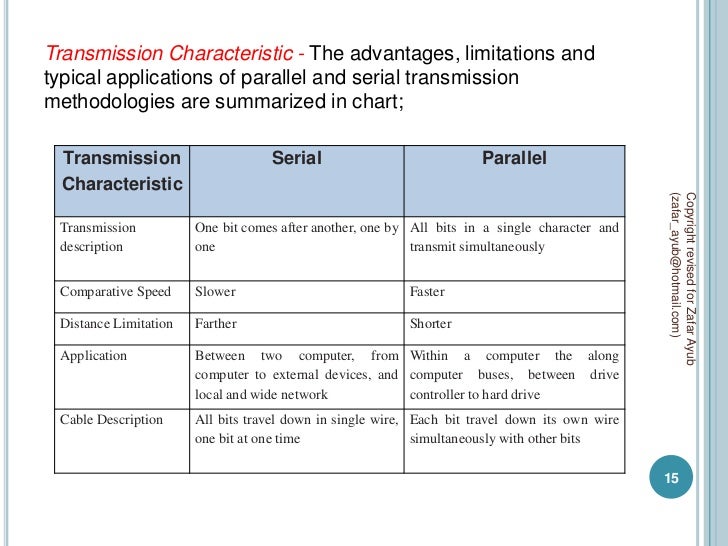
Advantages And Disadvantages Of Serial And Parallel Data Transmission
The advantage of using the asynchronous method is that no synchronization is required between the transmitter and receiver devices. It is also a more cost effective method. A disadvantage is that data transmission can be slower, but this is not always the case. In Parallel Transmission, every bit needs a wire to transfer data from one place to. What are advantages and disadvantages in intercultural communication?
Teach Any Computer Science Class We have put together a full GCSE Computer Science curriculum that will give you all the teaching materials you need to teach any topic. Whether you're a brand new Computer Science teacher, or you've been teaching ICT for years, our resources will save you hours and hours of lesson preparation every single week. There are two ways to transfer data between computers: Serial Transmission and Parallel Transmission.
Serial Transmission Data is sent bit by bit from one computer to another in two directions. Each bit has a clock pulse rate. Eight bits are transmitted at a time with a start and stop bit known as a parity bit, which is 0 and 1 respectively. Data cables are used when transmitting data to a longer distance. The data cable has D-shaped 9 pin cable that connects the data in series.
Categories of Serial Transmission Asynchronous transmission – an extra bit is added to each byte to alert the receiver on the arrival of new data. 0 is used as a start bit while 1 used as a stop bit. Synchronous transmission – no extra bit is added to each byte. Data is transferred in batches which contains multiple bytes. Parallel Transmission Several bits are transmitted together simultaneously with one clock pulse rate. It transmits quickly as it utilizes several input and output lines for sending the data. It uses a 25-pin port with 17 signal lines and 8 ground lines. Vaenga zhelayu peredelka prikoljnaya.
The 17 signal lines are divided as • 4 lines – initiates handshaking • 5 lines – communicates and notifies errors • 8 lines – transfers data Applications Serial transmission occurs between two computers or from a computer to an external device located some distance away. Anaglyph ax for kmplayer pc. Parallel transmission can take place within a computer system, through a computer bus or to an external device located a close distance away.
Examples An example of serial mode transmission include connection between a computer and a modem using the RS-232 protocol. An RS-232 cable can accommodate 25 wires, but only two of these wires are for data transmission, the rest are for overhead control signaling.
The two data wires run on simple serial transmission in either direction. In this example, a computer may be far from the modem, making parallel transmission very expensive. With this, speed of transmission is considered less important compared to the economic advantage of serial transmission. An example of parallel mode transmission include connection between a computer and a printer. Most printers are within 6 meters or 20 feet from the transmitting computer and the slight cost for extra wires is offset by the added speed gained through parallel transmission of data.